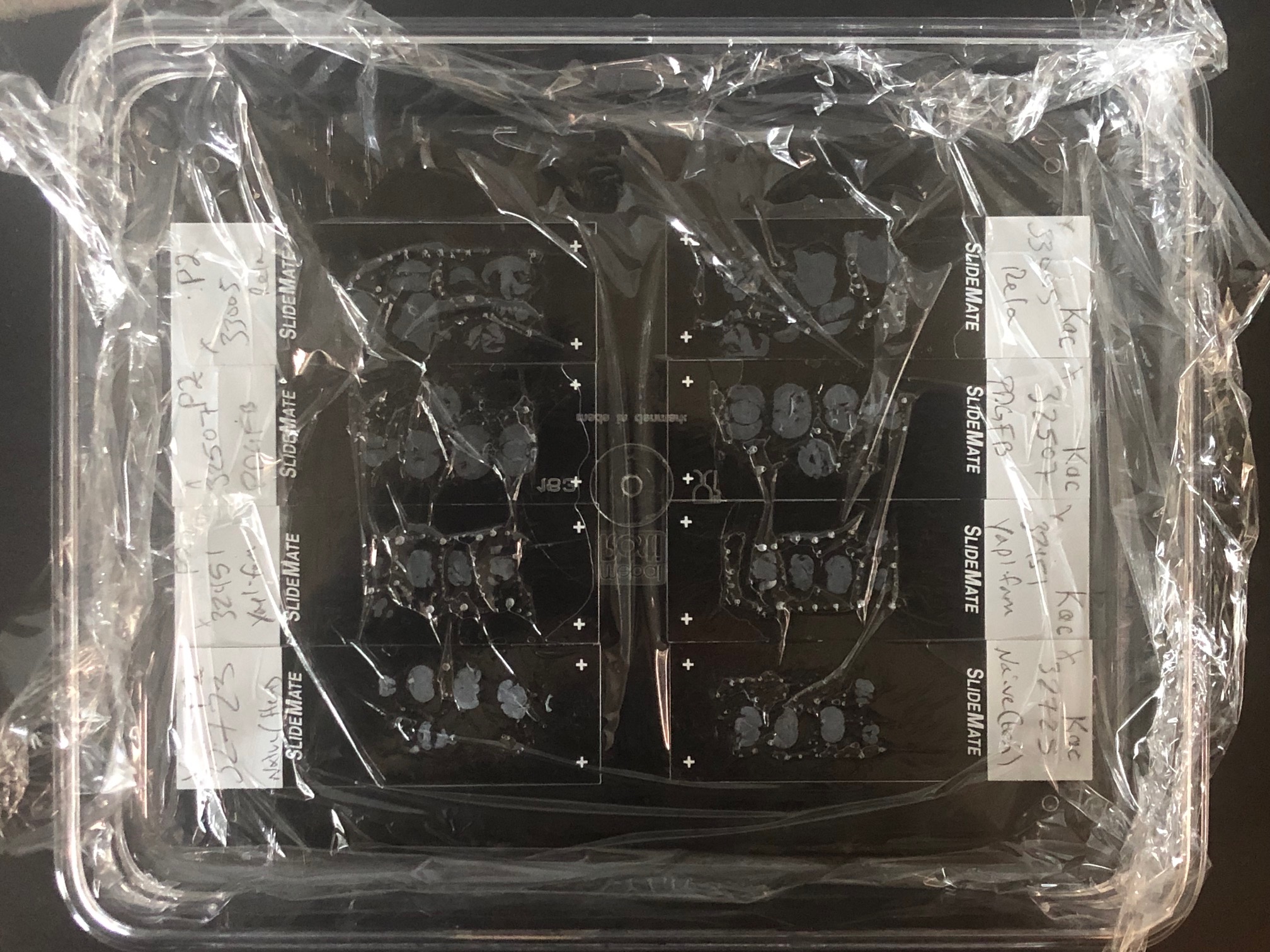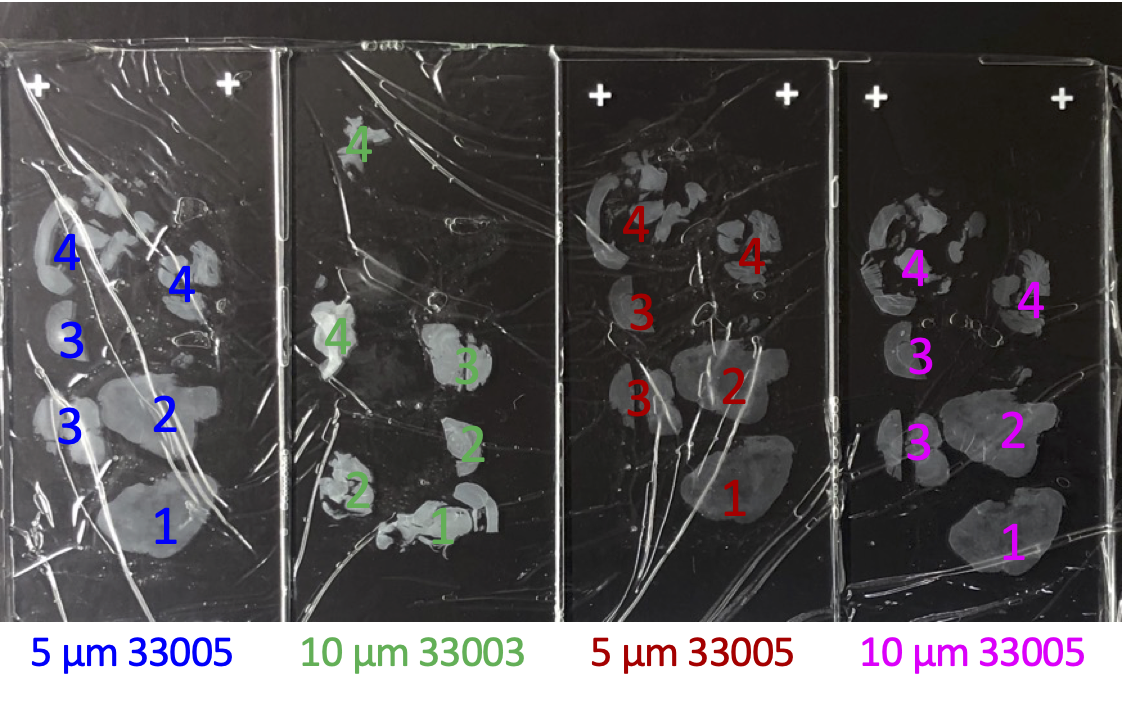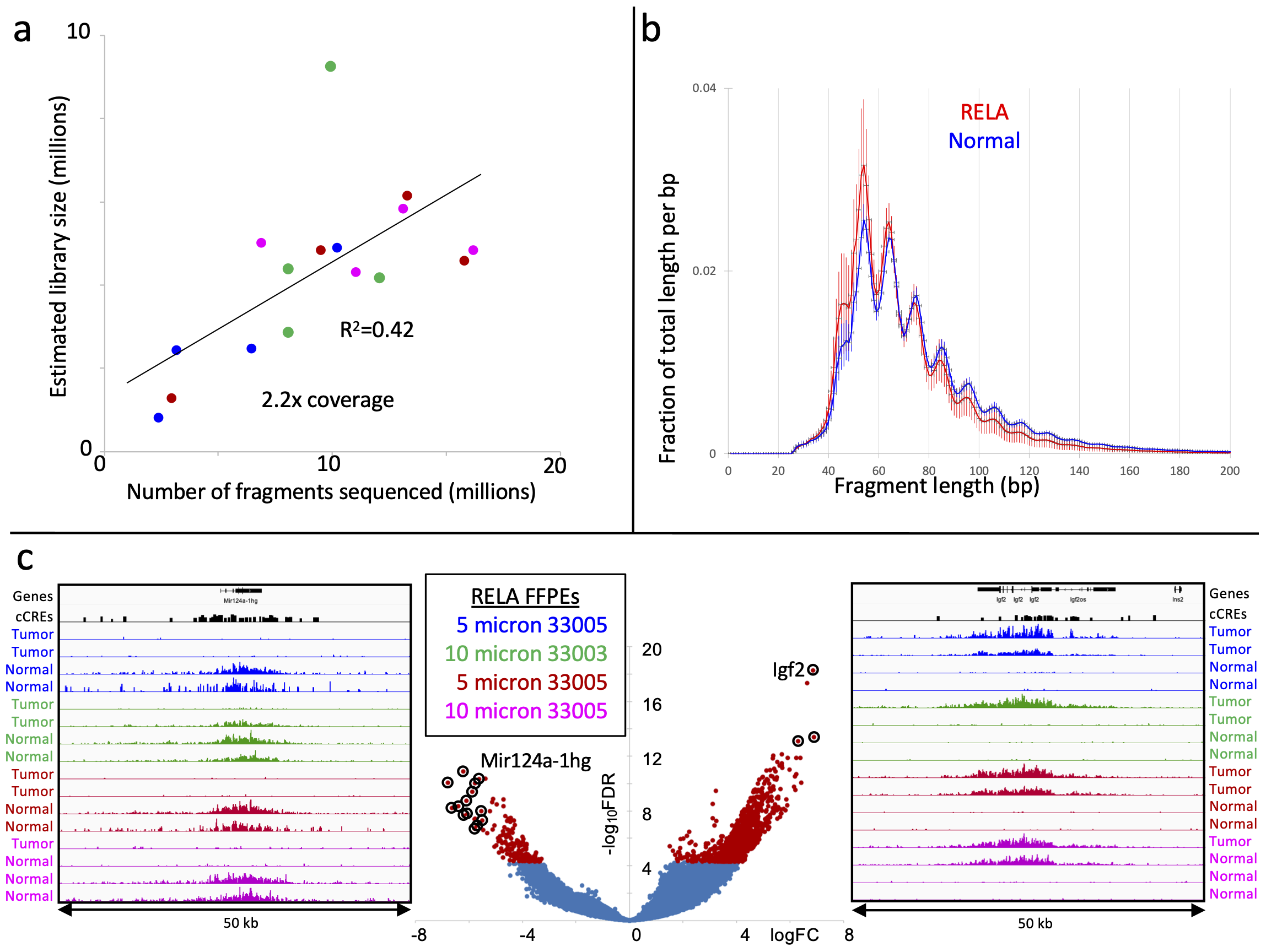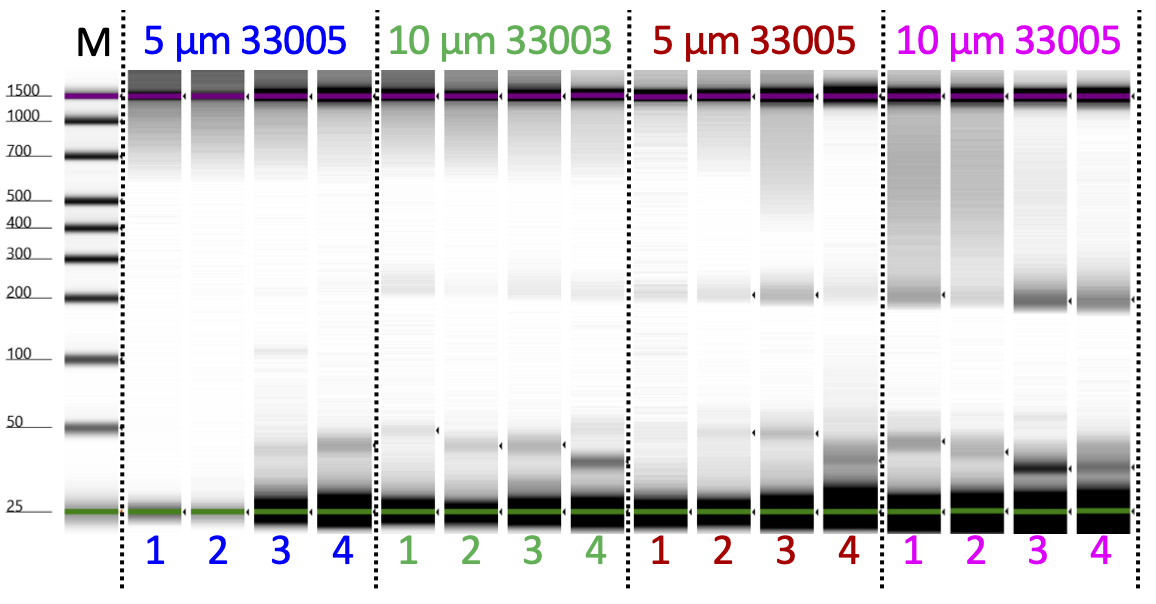CUTAC for FFPEs
Steven Henikoff
Abstract
For more than a century, Formalin Fixed Paraffin Embedded (FFPE) sample preparation has been the preferred method for long-term preservation of biological material. However, the use of FFPE samples for epigenomic studies has been difficult because of chromatin damage from long exposure to high concentrations of formaldehyde. Previously, we introduced Cleavage Under Targeted Accessible Chromatin (CUTAC), an antibody-targeted chromatin accessibility mapping protocol based on CUT&Tag. Here we show that simple modifications of our single-tube CUTAC protocol are sufficient to produce high-resolution maps of paused RNA Polymerase II (RNAPII) at enhancers and promoters using FFPE samples. We find that transcriptional regulatory element differences produced by FFPE-CUTAC distinguish between mouse brain tumors and identify and map regulatory element markers with high confidence and precision, including microRNAs not detectable by RNA-seq. Our simple workflows make possible affordable epigenomic profiling of archived biological samples for biomarker identification, clinical applications and retrospective studies.

Before start
Steps
REAGENT SETUP (for up to 16 samples)
Cross-link reversal buffer Mix 800 µL 1 M Tris-HCl pH8.0, 200 µL dH2O.
Rinse buffer Mix 1 mL 1 M HEPES pH 7.5 and 1.5 mL 5 M NaCl, 250 µl Triton-X100 and bring the final volume to 50 mL with dH2O.
Triton-Wash buffer Mix 1 mL 1 M HEPES pH 7.5, 1.5 mL 5 M NaCl, 250 µl Triton-X100 and 12.5 μl 2 M spermidine, bring the final volume to 50 mL with dH2O, and add 1 Roche Complete Protease Inhibitor EDTA-Free tablet. Store the buffer at 4 °C for up to 2 days.
Primary antibody solution Mix 17 µl RNA Polymerase II-Ser5p: (Cell Signaling Technologies (D9N5I) mAb #13523) + 423 µl Triton-Wash buffer (1:25).
Secondary antibody solution Mix 17 µ guinea pig anti-rabbit (Antibodies Online) with 423 µL Triton-Wash buffer (1:25).
Protein A(G)-Tn5 solution Mix 21 µl Protein A(G)-Tn5 (Epicypher cat. no. 15-1117) with 419 µL Triton-Wash buffer (1:20).
CUTAC-DMF Tagmentation buffer Mix 17.7 mL dH2O, 4 mL N,N-dimethylformamide, 220 µl 1 M TAPS pH 8.5, and 110 µl 1 M MgCl2 (10 mM TAPS, 5 mM MgCl2, 20% DMF). Store the buffer at 4 °C for up to 1 week.
TAPS wash buffer Mix 1 mL dH2O, 10 µl 1 M TAPS pH 8.5, 0.4 µl 0.5 M EDTA (10 mM TAPS, 0.2 mM EDTA). Store at room temperature.
1% SDS/ProtK Release solution (For 16 samples) Mix 10 µl 10% SDS and 1 µl 1 M TAPS pH 8.5 in 79 µl dH2O. Just before use add 10 µL Thermolabile Proteinase K (NEB cat. no. P8111S).
6% Triton Mix 600 µl 10% Triton-X100 + 400 µl dH2O. Store at room temperature.
Deparaffinization in hot cross-link reversal buffer (1.5 hr).
Place slides in cross-link reversal buffer in a slide holder that is filled to completely cover the slides. Place the holder in a water bath at 85 oC and incubate for at least an hour. The paraffin will melt and float to the top. Remove slide holder to an ice-cold water bath to chill. Adding more solution to overfill will drain off any solid paraffin.
Remove slides to Rinse Buffer in a slide holder.
For Option 1 (on-slide), continue with Step 5. For Option 2 (Magnetic Beads), skip to Step 22.
Option 1: On-slide FFPE-CUTAC Incubation with primary antibody ( 1.5 hr).
For each slide, remove from slide holder, wick off excess liquid with a Kimwipe and place tissue-side up on a dark surface. Carefully pipette ~100 µl primary antibody solution over the tissue.
Cover the clear portion of the slide with a rectangle of plastic film using surface tension to spread the liquid, while excluding large bubbles and wrinkles. Place wrapped slides separated in a dry slide holder (Figure 2).



Incubate horizontallly for at least 1 hr.
Remove plastic wrap and gently rinse slide with 1 mL Triton-Wash buffer.
Option 1: Incubation with secondary antibody ( 1.5 hr).
Wick off excess liquid with a Kimwipe and place tissue-side up on a dark surface. Carefully pipette ~100 µl primary antibody solution over the tissue.
Cover the clear portion of the slide with a rectangle of plastic film using surface tension to spread the liquid, while omitting bubbles and folds. Place wrapped slides separated in a dry slide holder.
Incubate horizontally for at least 1 hr.
Remove plastic wrap and gently rinse slide with 1 mL Triton-Wash buffer. Drain on paper towel or Kimwipe and place in a slide holder filled with Triton-Wash buffer for 10 min.
Option 1: Binding Protein A(G)-Tn5 adapter complex (1.5 hr)
Remove from slide holder and wick off excess liquid with a Kimwipe. Place tissue-side up on a dark surface. Carefully pipette ~100 µl pA(G)-Tn5 solution over the tissue.
Cover the clear portion of the slide with a rectangle of plastic film using surface tension to spread the liquid, while omitting bubbles and folds. Place wrapped slides separated in a dry slide holder.
Incubate horizontally for at least 1 hr.
Remove plastic wrap and gently rinse slide with 1 mL Triton-Wash buffer. Drain on paper towel or Kimwipe and place in a slide holder filled with Triton-Wash buffer for 10 min. Drain and place in a slide holder with Triton-Wash buffer for 10 min.
Drain on paper towel or Kimwipe and place in a slide holder filled with 10 mM TAPS pH 8.5 for 10 min.
Option 1: Tagmentation and dissection (1.5 hr)
Remove slides and drain on paper towel or Kimwipe and place in a slide holder containing cold Tagmentation buffer.
Incubate 1 hr in a water bath at 55 oC.
Remove each slide to a slide holder containing 10 mM TAPS pH 8.5 to hold.
Remove slide from slide holder, drain and use a Kimwipe to remove excess liquid from the top surface. Dissect or scrape using a total of no more than 5 µL 1% SDS/Thermolabile Proteinase K solution per PCR tube. For recovering all tissue from the slide dice and scrape with a safety razor blade. Proceed to Fragment release (Step 46).
Option 2: FFPE-CUTAC using Biomag-amine beads
Remove slide from slide holder, drain and use a Kimwipe to remove excess liquid from the top surface. For recovering all tissue from the slide use a safety razor blade, first dicing the tissue, then scraping into a 2 ml tube containing 1 ml Triton-wash buffer.
Add 1 µl Bio-mag Plus amine beads (48 mg/ml) per 8 final PCRs.
Pass through a 20-22 gauge 1" needle using a Luer-lock glass syringe ~20 times to break up tissue. Divide and transfer into PCR tubes.
Option 2: Incubation with primary antibody (1.5 hr)
After a quick full spin, place the tubes on the magnet stand to clear and withdraw the liquid.
Resuspend beads in 25 µl primary antibody solution followed by vortexing.
Incubate at least 1 hr on Rotator or Nutator at room temperature.
Option 2: Incubation with secondary antibody (1.5 hr)
After a quick full spin, place the tubes on the magnet stand to clear and withdraw the liquid..
Resuspend beads in 25 µl secondary antibody solution followed by vortexing.
Incubate at least 1 hr on Rotator or Nutator at room temperature.
After a quick full spin, place the tubes on the magnet stand to clear and remove and discard the supernatant with two successive draws, using a 20 µl tip with the pipettor set for maximum volume.
With the tubes still on the magnet stand, carefully add 500 µl of Wash buffer. The surface tension will cause the beads to slide up along the side of the tube closest to the magnet.
Slowly withdraw 460 µl of supernatant with a 1 mL pipette tip without disturbing the beads.
After a quick full spin, place the tubes back into the magnet stand and remove the remaining supernatant with a 20 µl pipettor multiple times if necessary, to remove the entire supernatant without disturbing the beads. Proceed immediately to the next step.
Option 2: Binding Protein A(G)-Tn5 adapter complex
Mix pAG-Tn5 pre-loaded adapter complex in Triton-Wash buffer following the manufacturer's instructions (e.g. 1:20 for EpiCypher pAG-Tn5).
Pipette in 25 µl per sample of the pA(G)-Tn5 mix followed by vortexing.
After a quick spin, place the tubes on a Rotator or Nutator at room temperature for 1 hr or 4 °C overnight.
After incubating in the rotator, perform a quick full spin and place the tubes in the magnet stand.
Carefully remove the supernatant using a 20 µl pipettor as in Step 31.
With the tubes still on the magnet stand, add 500 µl of the Triton-Wash buffer.
Slowly withdraw 460 µl with a 1 ml pipette tip without disturbing the beads as in Step 33.
After a quick full spin, place the tubes back on the magnet stand and remove and discard the supernatant with a 20 µL pipettor using multiple draws.
Option 2: Tagmentation (1.5 hr)
Resuspend the bead/FFPE pellet in 50 µl CUTAC-DMF tagmentation solution (5 mM MgCl2, 10 mM TAPS, 20% DMF, 0.05% Triton-X) while vortexing. Incubate 1 hr 55 °C in thermocycler.
Place tubes on a magnet stand and remove and discard the supernatant with a 20 µL pipettor using multiple draws then resuspend the beads in 50 µL TAPS wash and mix by vortexing.
Add 5 µL SDS/Proteinase K, vortex, spin, revortex and spin. Proceed to Fragment release (Step 46).
Fragment release (1.5 hr)
After a full speed spin, incubate at 37 ºC for 30 min and 58 ºC for 30 min (programmed in succession in a PCR cycler with a heated lid) to release pA-Tn5 from the tagmented DNA.
PCR (1 hr)
To the PCR tube containing the bead slurry add 15 µl of Triton neutralization solution + 2 µl of 10 µM Universal or barcoded i5 primer + 2 µl of 10 µM uniquely barcoded i7 primers, using a different barcode for each sample. Vortex on full speed and place tubes in the metal tube holder on ice.
Add 25 µl NEBnext (non-hot-start), vortex to mix, and perform a quick spin. Place the tubes immediately in the thermocycler and proceed immediately with the PCR.
Begin the cycling program with a heated lid on the thermocycler:
Cycle 1: 58 °C for 5 min (gap filling)
Cycle 2: 72 °C for 5 min (gap filling)
Cycle 3: 98 °C for 5 min
Cycle 4: 98 °C for 10 sec
Cycle 5: 63 °C for 30 sec
Cycle 6: 72 °C for 1 min
Repeat Cycles 4-6 11 times
Hold at 8 °C
Post-PCR Clean-up (30 min)
After the PCR program ends, remove tubes from the thermocycler and add 65 µL of SPRI beads (ratio of 1.3 µL of SPRI beads to 1 µL of PCR product). Mix by pipetting up and down.
Let sit at room temperature 5-10 min.
Place on the magnet stand for a few minutes to allow the solution to clear.
Remove and discard the supernatant.
Keeping the tubes in the magnet stand, add 200 µL of 80% ethanol.
Completely remove and discard the supernatant.
Repeat Steps 55 and 56.
Perform a quick spin and remove the remaining supernatant with a 20 µl pipette, avoiding air drying the beads by proceeding immediately to the next step.
Remove from the magnet stand, add 22 µl 10 mM Tris-HCl pH 8 and vortex at full speed. Let sit for 5 min to 1 hr.
Place on the magnet stand and allow to clear.
Remove the liquid to a fresh 1.5 mL tube with a pipette, avoiding transfer of beads.
Tapestation analysis and DNA sequencing
Determine the size distribution and concentration of libraries by capillary electrophoresis using an Agilent 4200 TapeStation with D1000 reagents or equivalent.
Mix barcoded libraries to achieve equal representation as desired aiming for a final concentration as recommended by the manufacturer. After mixing, perform an SPRI bead cleanup if needed to remove any residual PCR primers.
Perform paired-end Illumina sequencing on the barcoded libraries following the manufacturer’s instructions.
Data processing and analysis
Align paired-end reads to hg19 using Bowtie2 version 2.3.4.3 with options: --end-to-end --very-sensitive --no-unal --no-mixed --no-discordant --phred33 -I 10 -X 700. For mapping E. coli carry-over fragments, we also use the --no-overlap --no-dovetail options to avoid possible cross-mapping of the experimental genome to that of the carry-over E. coli DNA that is used for calibration. Tracks are made as bedgraph files of normalized counts, which are the fraction of total counts at each basepair scaled by the size of the hg19 genome.

Our CUT&Tag Data Processing and Analysis Tutorial on Protocols.io provides step-by-step guidance for mapping and analysis of CUT&Tag sequencing data. Most data analysis tools used for ChIP-seq data, such as bedtools, Picard and deepTools, can be used on CUT&Tag data. Analysis tools designed specifically for CUT&RUN/Tag data include the SEACR peak caller also available as a public web server and CUT&RUNTools.


